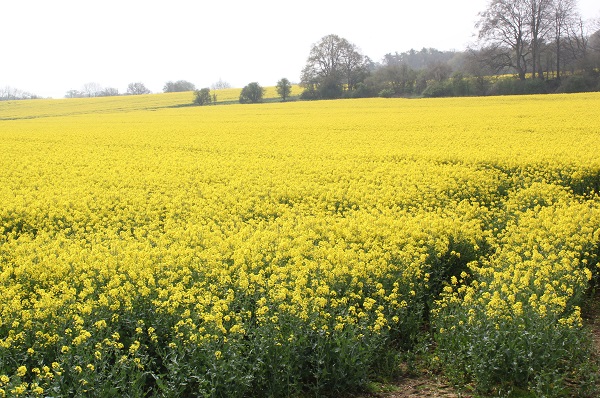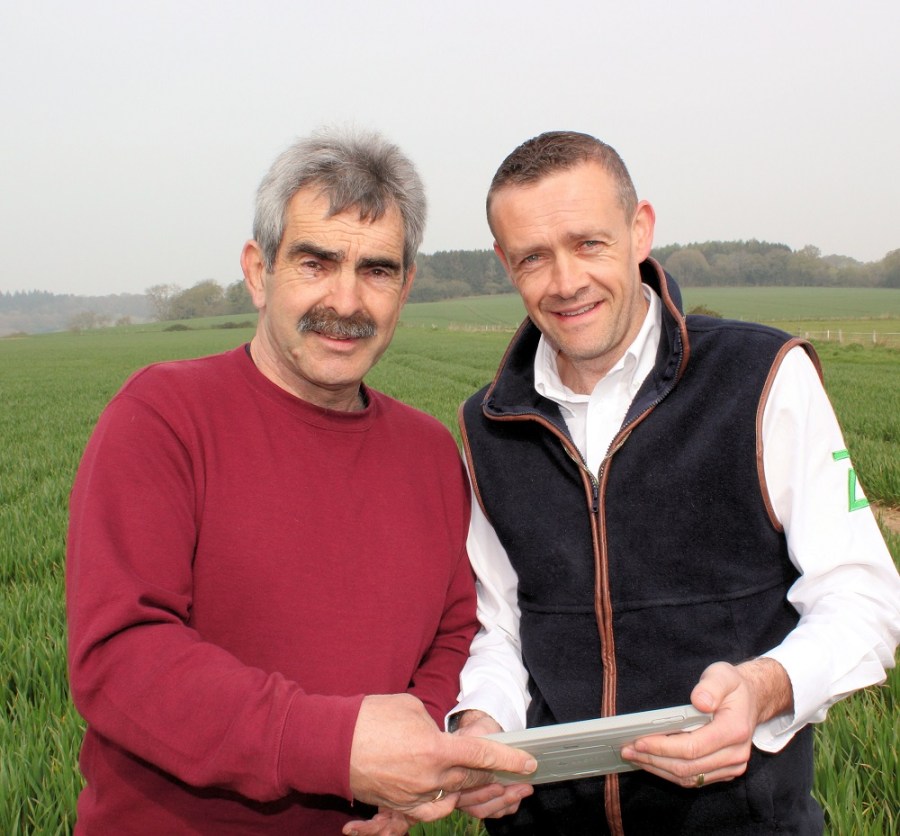Digital agronomy potentially offers more than just a step on from precision farming. CPM visits a Hants estate that’s made the most of the Rhiza platform to find out where the opportunities lie.
As our confidence in the Contour yield predictions grows we will be able to push harder with nitrogen, fungicides and PGRs.
By Rob Jones
At Breamore Estate near Fordingbridge, Hants, farm manager David Northway has been precision farming for more than five years now and is an accomplished user of the Contour digital platform.
It brings accurate precision input planning and management, he says – these and ‘hyper-local’ weather data available through the service help him and his Agrii agronomist, Roy Willis keep profitability on track.
But they believe Rhiza digital agronomy offers far greater potential. In particular, there’s the opportunity to make the better use of high resolution satellite imaging, crop yield predictions claimed to be increasingly accurate, and ‘big data’ from the latest research and grower experience.

More precise management means far more even crops at Breamore Estate.
The estate’s 550 ha of arable ground was scanned by SoilQuest in 2012/13 to address the biggest challenge it presents – a vast range of soil types from hungry, drought-prone gravels to thin, flinty chalk downland and almost everything in between.
“All our land, with the exception of a single field, is classified as Grade 3 or less,” explains David. “And many fields have soils varying from one extreme of type to the other. So even setting up the drill for each is always a compromise.”
The quality of the Breamore land is reflected in its yields. The 200ha of first, mainly milling wheats that are the mainstay of the rotation average 8.5t/ha and spring malting barley typically delivers around 7t/ha. Its acute variation has always been equally clear in historic wheat yields varying from around 5t/ha to 12t/ha across fields.
“This variation was all too obvious, with our original SoilQuest management zone sampling showing generally reasonable potash indices but phosphates all over the place – and rock bottom in some areas,” notes Rhiza digital and precision business manager, Chris Hoskins who undertook the scanning.
Having ‘ground-truthed’ the zoning, adding their own knowledge and experience of the land to interpret the results, the Breamore Estate team first set about targeting the low phosphate and pH areas with variable rate Fibrophos and liming.
Repeat testing of the zones in 2016 showed P and gravel pH indices all up to target levels. This initially meant increasing phosphate inputs. However, the farm records show total MOP and TSP usage now running at just 13t/yr, against the 30t previously used annually in blanket applications.
“At the same time, we varied our wheat nitrogen dressings by plus or minus 20% in places to tackle the most acute yield variations,” recalls Roy “This was mainly because we didn’t then have a drill with a variable seed rate capability. It certainly helped, but took a lot to balance this with our PGR programme.
“The arrival of an Amazone Cayenna drill in 2015 meant we were able to address the main source of crop variation much more effectively with variable seeding. So we no longer need to vary our N rates these days. Having said that, the Contour imagery and yield predictions do allow us to adjust rates to actual crop growth after the first spring split wherever we want to.”
Of all the precision technologies, variable rate drilling has undoubtedly had the biggest impact at Breamore, he says.
With the legacy of ‘hideous’ sterile brome problems, both wheat and spring barley seed rates had been previously been kept distinctly on the high side for the greatest crop survival and competition. Yet David has long recognised bushel weights as the key to performance on his ground.
“Wherever our crops are too thick we suffer through lower bushel weights,” he points out. “So getting plant populations right across the fields is crucial. Until we could vary seed rates to reflect soil variations – not to mention areas of particular grassweed concern – we simply couldn’t afford to reduce our rates.
“Now, though, we can bring them down with confidence in many areas and match them to the tillering capacities of the varieties we use and when we sow them, based on detailed Agrii trial work. This has really helped reduce our bushel weight variations for the most consistent performance.”
With only minimal problems from blackgrass, wheat drilling starts in early Oct, with rates of Crusoe and KWS Zyatt now varied from 285 seeds/m² to 370 seeds/m² depending on the variety, timing and conditions. Rates of RGT Planet spring barley are also varied from 330-400 seeds/m².
“Variable rate winter wheat drilling helps give the most even canopies going into March,” says Chris. “After this, the season drives what David and Roy do. Which is where the Rhiza NDVI and crop biomass imagery come into their own.”
This uses the Planet system for optical imaging alongside ESA’s Sentinel satellite for all-weather synthetic aperture radar (SAR) monitoring, claimed to offer a nine-fold higher resolution than other providers and much greater detail. The service also provides a revisit time of 1.5 days against a seven-day standard resulting in an improved image frequency with low cloud interference.
Although, Chris accepts last summer’s exceptional drought got in the way of the SAR yield predictions on the Breamore gravels, the Rhiza wheat growth modelling predicted final 2018 yields to within 0.2t/ha in many places nationally. So, as the system becomes increasingly accurate for their ground with additional ‘machine-learning’ from each new season’s data, the team is looking forward to using this facility increasingly positively in its management.
“Our five-year wheat average may be 8.5t/ha but we can bring in 10.25t/ha if the season really suit us,” Roy points out. “We will continue to base all our input-planning on 8.5t/ha. But as our confidence in the Contour yield predictions grows we will be able to push harder with nitrogen, fungicides and PGRs should they suggest it will be worthwhile.
“They’ll also give us the confidence to boost later foliar nitrogen to maintain our milling wheat proteins in the face of the yield dilution from more favourable crop growth.”
David likes the convenience of viewing satellite images of every crop whenever he wants to using the Contour app. “It’ll become more and more useful to us both,” he adds.
“Last season we picked up a couple of areas of unusually dense early crop growth which closer inspection revealed to be patches of blackgrass brought in by outside equipment. So we were able to nip them in the bud and mark them with pins on our field maps for future reference.
“Equally, Roy and I are able to draw each other’s attention to any areas of unexplained crop growth we can check out in our field-walking and fieldwork. It may be we’ve got early signs of rust that warrant particular attention; we need to schedule extra soil or nutrient testing to fine-tune our nutrition; or we can spot areas of possible compaction or poor drainage we can investigate and deal with at the earliest rotational opportunity.
“We’ll also be able to integrate the much more accurate yield mapping of our recently acquired New Holland combine, using the actual performance of each area of each field each season to improve our planning. And we should find local alerts tracking yellow rust in key varieties, flea beetle pressures and a range of other problems through the system giving us even greater value.”
Two additional elements of Rhiza digital agronomy the team are already using to great effect in their planning at Breamore are accurate local weather data and automatic crop input calculation.
Wind speed indications at boom height rather than the national 10m standard as well as rainfall forecasts are making a big difference to spray planning, while accurate local soil temperature predictions are helping propyzamide scheduling.
On top of this, David uses the system to calculate fertiliser and seed requirements for each field based on individual management zones and target yields, informed by RB209 and the latest Agrii research nutritional and variety research.
It even automatically adjusts for the nutrient value of the 30t/ha of compost he applies to most fields every other year to improve organic matter. This means he only orders exactly what he needs each season. And by doing this well in advance he can buy at the most favourable rates.
“The usability and accuracy of the Rhiza system is proving more and more valuable in allowing us to be increasingly precise in the inputs we use and when as well as where we use them,” David concludes.
“But the future is what really excites us. We have all the building blocks for the most profitable digital agronomy in place and look forward to using them to greater and greater effect in the years ahead.”
Digital Vision
As arable farms progress towards a digital future, it can be difficult to know which forms of data generation, capture and analysis provide a really worthwhile benefit to the business, and which are costly and time-wasting distractions. CPM is working with some of the industry’s leading companies in this area to bring growers their Digital Vision. These articles lay out the significant steps on the journey towards the data-enabled farm. CPM would like to thank Origin for sponsoring this article and for sharing its Digital Vision.
Operating in Ireland, Ukraine, Poland, Romania, Belgium and Brazil as well as the UK, Origin Enterprises plc is determined to be the leading provider of value-added services, technologies and strategic inputs for profitable and truly-sustainable farming.
Pioneering digital and precision agronomy for well over a decade, its Agrii, Rhiza and Ag-Space businesses remain at the forefront of developments in agricultural data and crop management research, systems and knowledge exchange.
All this work is focussed on enabling farmers and their advisers to harness the power of digital agriculture for the greatest crop and grassland management gains at the least possible cost.




